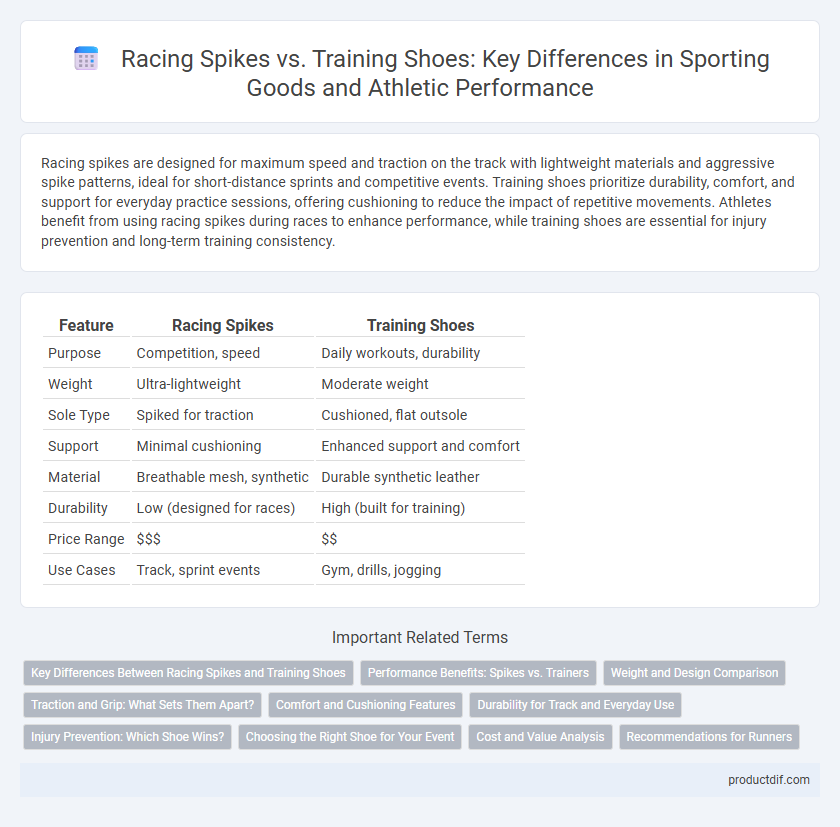Racing spikes are designed for maximum speed and traction on the track with lightweight materials and aggressive spike patterns, ideal for short-distance sprints and competitive events. Training shoes prioritize durability, comfort, and support for everyday practice sessions, offering cushioning to reduce the impact of repetitive movements. Athletes benefit from using racing spikes during races to enhance performance, while training shoes are essential for injury prevention and long-term training consistency.
Table of Comparison
| Feature | Racing Spikes | Training Shoes |
|---|---|---|
| Purpose | Competition, speed | Daily workouts, durability |
| Weight | Ultra-lightweight | Moderate weight |
| Sole Type | Spiked for traction | Cushioned, flat outsole |
| Support | Minimal cushioning | Enhanced support and comfort |
| Material | Breathable mesh, synthetic | Durable synthetic leather |
| Durability | Low (designed for races) | High (built for training) |
| Price Range | $$$ | $$ |
| Use Cases | Track, sprint events | Gym, drills, jogging |
Key Differences Between Racing Spikes and Training Shoes
Racing spikes feature lightweight, aggressive designs with spikes on the outsole for maximum traction and speed on track surfaces, while training shoes prioritize durability, cushioning, and support for daily workouts and varied terrain. Racing spikes are constructed with minimal padding and a snug fit to enhance performance but lack the shock absorption and stability found in training shoes. Training shoes offer greater versatility, making them suitable for longer, high-impact sessions, whereas racing spikes are specialized for short, high-intensity races.
Performance Benefits: Spikes vs. Trainers
Racing spikes offer enhanced traction and lightweight design, enabling sprinters and middle-distance runners to achieve faster acceleration and improved grip on track surfaces. Training shoes provide superior cushioning and support, reducing injury risk during high-volume workouts and enhancing overall foot stability. Choosing spikes over trainers during competitions maximizes speed, while trainers are optimized for comfort and durability in daily training sessions.
Weight and Design Comparison
Racing spikes are designed with ultra-lightweight materials and minimal cushioning to maximize speed and track performance, often weighing between 4-6 ounces. Training shoes, by contrast, prioritize durability and support with heavier construction, typically ranging from 8-12 ounces to withstand repetitive workouts and diverse training conditions. The sleek, aerodynamic design of racing spikes enhances traction on track surfaces, while training shoes incorporate sturdier soles and more substantial padding for all-around comfort and injury prevention.
Traction and Grip: What Sets Them Apart?
Racing spikes feature strategically placed metal or ceramic spikes on the outsole, providing superior traction and grip on track surfaces for explosive acceleration and quick turns. Training shoes typically have flatter, rubber soles designed for versatility and durability on various surfaces but lack the specialized spike arrangement, resulting in less grip during high-speed sprints. The difference in traction technology directly impacts performance, with spikes optimizing grip for racing and training shoes offering stability and comfort for everyday workouts.
Comfort and Cushioning Features
Racing spikes prioritize lightweight design and minimal cushioning to maximize speed and track feel, often sacrificing long-term comfort for performance. Training shoes feature enhanced cushioning and support to absorb impact during workouts, promoting comfort and reducing injury risk. Athletes seeking durability and comfort opt for training shoes, while racers choose spikes for responsiveness and track traction.
Durability for Track and Everyday Use
Racing spikes offer superior track performance with lightweight materials but tend to have lower durability for everyday use, often necessitating frequent replacements. Training shoes feature reinforced construction and cushioning designed to withstand daily wear and varied surfaces, providing enhanced longevity off the track. Selecting between the two depends on balancing the need for track-specific speed and long-term durability in daily training routines.
Injury Prevention: Which Shoe Wins?
Racing spikes provide superior traction and lightweight support essential for sprinting but lack substantial cushioning, increasing the risk of stress fractures and plantar fasciitis. Training shoes feature enhanced shock absorption and stability designed to protect joints and muscles during varied workouts, significantly reducing injury risk during repetitive training. For injury prevention, training shoes generally win due to their balanced support and cushioning suitable for high-impact and diverse physical activities.
Choosing the Right Shoe for Your Event
Racing spikes are specifically designed for short-distance sprinting and track events, featuring lightweight materials and sharp spikes for maximum traction and speed. Training shoes offer enhanced cushioning and support, ideal for endurance workouts and daily practice sessions. Selecting the right shoe depends on the event type, distance, and athlete's comfort needs to optimize performance and reduce injury risk.
Cost and Value Analysis
Racing spikes typically cost between $70 and $150, offering specialized design features like lightweight materials and aggressive traction for enhanced track performance, which justifies their premium price for competitive runners. Training shoes range from $50 to $120 and provide durability, cushioning, and support for daily workouts, delivering greater long-term value for athletes who prioritize comfort and injury prevention over speed. Evaluating cost versus value, racers benefit from spikes when aiming for peak performance in competitions, whereas training shoes are more cost-effective for consistent training and general athletic use.
Recommendations for Runners
Racing spikes provide lightweight construction and enhanced traction tailored for sprinting and track events, ideal for runners aiming to maximize speed during races. Training shoes offer superior cushioning and support, designed for daily workouts and long-distance endurance, helping to prevent injury and improve overall running mechanics. Runners should select racing spikes for competitive track performance and training shoes for regular practice and recovery sessions to balance speed and durability effectively.
Racing spikes vs Training shoes Infographic

 productdif.com
productdif.com